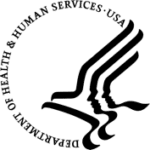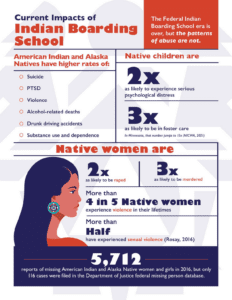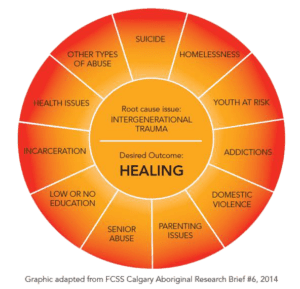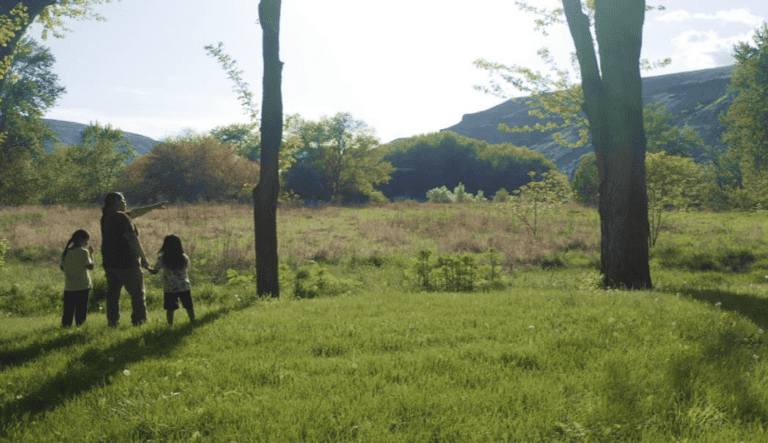
Figure 7. Native children looking at the land with an adult
Current Status of U.S. Indian Boarding Schools
The legacy of forced assimilation continued on through the foster care and adoption systems. In 1958 the BIA launched the Indian Adoption Project, which placed AI/AN children with urban White families (Lyslo, 1961). The BIA and the foster care system removed as many as 35% of AI/AN children—often from intact families—and placed them in White families with no connection to AI/AN culture (Johnson, 1999; Jones, 2007).
In the 1970s, people began to recognize this practice as forced assimilation. They also began to see that AI/AN children were healthier in AI/AN families, with less risk of behavioral and mental health problems than their counterparts in the foster care system who were disconnected from their cultures (Austin, 2009). In 1978, Congress passed the Indian Child Welfare Act (ICWA), which recognized a tribal government’s jurisdiction over tribally affiliated children both on- and off-reservation, in addition to specifying a preference for them to be placed with other AI/AN families (Office of the Federal Register, 1978). Several lawsuits have challenged ICWA since 1978, including Haaland v. Brackeen, a 2018 lawsuit that went to the Supreme Court, which in 2022 upheld the rights of tribes to place AI/AN children in AI/AN families.
Highlight: AI/AN children
AI/AN children are still removed from their families at disproportional rates. AI/AN children are up to four times as likely to end up in foster care as compared to non-AI/AN children. Additionally, only 38% of AI/AN children are placed in care with kin, and 52% of the children in the foster care system are adopted by non-Native families (Disproportionate, 2021 and Casey Family Programs, 2022).
The BIE is a division of the BIA under the U.S. Department of the Interior that provides culturally relevant education services and support to BIE-funded schools.
Highlight: Isolation
It is important to consider the isolation these students felt while in boarding school. Unlike today, they did not have access to cell phones or social media to keep in touch with loved ones back home. The only way to communicate was through letters, many of which went unanswered. The isolation from family and culture led many children to believe they were not wanted or even forgotten. This cultural estrangement has reverberated through generations and is something Native people are still grappling with today.
As of 2020, the BIE provided education services to 47,000 students across nearly 200 elementary and secondary schools, many of which are directly controlled by tribes and tribal school boards. While only 24 of the BIE-funded schools remain residential (U.S. Department of the Interior, 2023), the intergenerational impacts of boarding schools persist in AI/AN life.
Poetry
Poetry serves as a creative and therapeutic medium for individuals navigating grief and trauma. Through its unique ability to distill complex emotions into words and imagery, poetry offers a healing process that can be profoundly cathartic and transformational. Using the prompt below, write a poem, spoken word, or rap. Remember that poetry does not have to rhyme. Rather, focus on communicating your feelings through metaphor and meter/rhythm.
Poetry Prompts:
- When I focus on the strengths of the people who experienced boarding schools and what they and their families have overcome, I …
- If “healing” was a geological feature, what would it be?
- What is the shape of trauma? Are its edges hard, soft, round, jagged? Does it change when you touch it? Does it change over time?
Current Impacts
“Boarding schools impacted me, my family … I carry that trauma with me. All that trauma is handed down, the cultural loss, missing some of those things from the ‘normal human toolkit’… I want to talk about the experiences, understand the conscious choices my grandpa made that effected my uncles, aunties, and frankly even my children.”
− Eric Buffalohead, PhD. (Ponca Tribe of White Eagle), Chair of American Indian, First Nations, and Indigenous Studies, Augsburg University.
Collective identity is an important aspect of resilience. Feeling a strong sense of one’s membership in a group gives individuals a source of strength (Steffens et al., 2017). The identities of AI/AN people have been under attack for centuries, and health systems are just starting to acknowledge those impacts.
Figure 8. Current Impacts of Indian Boarding Schools. Click to expand.
Call to Action: Center Culture on the Pathway to Health
Center culture on the pathway to health. This approach recognizes tribal sovereignty and self-determination. “Indigenous culture as treatment addresses not only physical and mental health disparities but also accounts for structural issues of inequality and policy injustices, medical discrimination, marginalization, and exclusion” (BlackDeer, 2023).
Trauma and Its Impacts
The Difference Between Grief and Trauma
Grief and trauma are two distinct yet related experiences that can have a profound impact on individuals and communities. Grief is a natural response to loss, while trauma is a response to deeply distressing or life-threatening event(s). Dr. Gabor Mate explains that “trauma is not what happens to you, it’s what happens inside you as a result of what happened to you” (Bramley, 2023). Intergenerational trauma theory posits that trauma can affect subsequent generations if attachment injuries remain unaddressed and untreated (Ringel, 2005).
For survivors of Indian boarding schools in the United States, both grief and trauma are commonplace. The forced removal of AI/AN children from their families and communities; the loss of culture and language; the physical, emotional, and sexual abuse endured; and the many children who died at the Indian boarding schools all contribute to intergenerational group. trauma—grief is the natural response to these sustained harms and losses. Heart et al. (2011) describes historical unresolved grief as “the profound unsettled bereavement resulting from cumulative devastating losses, compounded by the prohibition and interruption of Indigenous burial practices and ceremonies.” Without healing, the destruction of this cultural identity is likely to impact future generations (Haskell & Randall, 2009).
Call To Action: Supporting Children and Families
To support children and families in regaining their cultural identity, remind them there is more than one way to begin their journey. They can start connecting through public events like ceremonies, powwows, traditional art, literature, film, social media, or through AI/AN service providers.
The legacy of the Indian boarding schools is marked by profound and enduring historical trauma, similar to the experiences of asylum seekers, refugees, Holocaust survivors, and others forcibly relocated. For some, forced removal from family and community and loss of cultural ties resulted in a profound sense of alienation.
Additionally, those who research AI/AN communities have long identified cultural discontinuity as a contributing factor to the lower graduation rates of AI/AN students (St. Germaine, 1995). Newbreast and Brave Heart (2000, 2011) describe historical trauma in terms of a persistence of cultural shock as a result of forced assimilation, which in turn creates negative self-identify, learned helplessness, and self-sabotaging behaviors.
Due to these long-term impacts of the boarding schools, Native people may experience the
following:
- Feeling like strangers to their own cultures and languages
- Feeling their identities have been reshaped by their trauma
- Loss of a sense of belonging
- Having poor long-term health outcomes
- Disproportional representation in the child welfare and special education systems
The trauma caused by adults at the boarding schools also impacted survivors’ ability to parent. Instead of experiencing traditional parenting, children in the boarding schools learned a detached parenting style that, when applied to the next generation, perpetuated their trauma. Researchers found that survivors of the boarding schools tended to have harsh parenting styles, trust issues, and difficulties forming relationships with their children and families (Olson & Dombrowski, 2019).
Call To Action: Culturally Relevant Education Models
Parents with family histories disrupted by the boarding schools or the child-welfare system benefit from parent education that models culturally relevant parenting strategies promoting family and community well-being.
Activities: Reflection questions for Indigenous readers
- How do my ancestors’ or family members’ boarding school experience(s) impact me or my children?
- How do I think this has manifested generationally?
- Who are some other people I can talk to about my family’s boarding school experiences?
- What supports do I have or need?
Unresolved grief and trauma can have lasting effects on people’s lives. Survivors may struggle with:
- Depression
- Anxiety
- Substance-use disorder (SUD)
- Post-traumatic stress disorder (PTSD)
- Complex post-traumatic stress disorder (C-PTSD)
Figure 9. Root causes of intergenerational trauma. Click to expand.
As many treatments for PTSD focus on addressing a single, traumatic event, the diagnosis might not adequately reflect the long-term symptoms that persist after prolonged, multigenerational abuse experienced within the Indian boarding schools.
For AI/AN people, such trauma is often compounded by ongoing oppression and the legacy of colonization. Therefore, although it is not yet listed in the DSM-5, C-PTSD—a type of PTSD resulting from ongoing, repeated trauma—may be a more appropriate diagnosis for boarding school survivors (Bellamy & Hardy, 2015).
Decolonizing the healing process for AI/AN people who have experienced grief and trauma is essential. AI/AN healing practices and traditional knowledge systems offer pathways to address As many treatments for PTSD focus on addressing a single, traumatic event, the diagnosis might not adequately reflect the long-term symptoms that persist after prolonged, multigenerational abuse experienced within the Indian boarding schools the complex trauma of boarding schools. These approaches emphasize holistic healing, community support, and reconnection to cultural identity.
Impact of Trauma on Brain Development
Trauma physically reshapes the brain (van der Kolk, 2014). Early childhood trauma, in particular, is associated with cognitive impairment, psychiatric disorders, and poor adult functioning (Bücker et al., 2012). Children exposed to adverse childhood experiences (ACE) exhibit changes in the developing brain regions responsible for learning, memory, and emotional regulation (Anda et al., 2006). In a 2020 study, the average ACE score among AI/AN people was 2.32 points higher than those identifying as White (Giano et al., 2021). The historical trauma of removal, genocide, and cultural oppression contributes to this disparity.
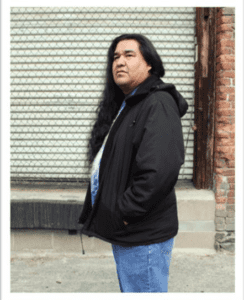
Figure 10. Native man standing in front of a building
Experiencing multiple ACEs can also increase the risk of developing PTSD (van der Kolk, 2014). Symptoms include flashbacks, nightmares, and hypervigilance, as traumatizeD people are often subconsciously scanning for threats. This constant fight-or-flight response impedes both social interaction and learning, and can often result in a misdiagnosis of attention deficit disorder or other psychiatric conditions. It is important to note that psychotropic medications are frequently used to treat children with trauma who are incorrectly diagnosed with bipolar or mood dysregulation disorder (van der Kolk, 2015). The psychotropic drugs used to treat these disorders, when given to misdiagnosed children, can interfere with relationships and development of age- appropriate skills (van der Kolk, 2015, p. 228). Additionally, the persistent effects of trauma on the brain can cause long-term disruption to the norepinephrine and cortisol systems, affecting other vulnerable neural structures (Bremmer, 2006). Taken together, these impacts can lead to heightened stress responses that contribute to long-term physical and mental health problems, including cardiovascular disease, depression, and anxiety (American Psychological Association, 2023).
Activating Latent Trauma
Trauma can have long-term effects on individuals, disrupting their ability to regulate internal states and leading to feelings of helplessness. When exposed to reminders of their trauma, individuals may exhibit retraumatization behaviors, such as hyperarousal or dissociation. Even professionals are often surprised at how minimal stressors can activate major trauma responses (van der Kolk, 2014; Perry et al, 1995).
Highlight: Educators, Medical Professionals, and Behavioral Health Providers
Educators, medical professionals, and behavioral health providers should be sensitive to environmental cues that may cause a reaction from a child who has experienced trauma. By anticipating difficult times and providing support, professionals can help to create a safe and supportive environment for children and families who have experienced trauma.
Call To Action: Trauma Responses
Trauma responses vary from person to person. Creating a safe space for open communication about potential activators is crucial to avoid re-experiencing trauma. Possible accommodations can include, but are not limited to, actions such as warning participants before anticipated loud noises, asking for permission to physically touch someone, and using calm voices.
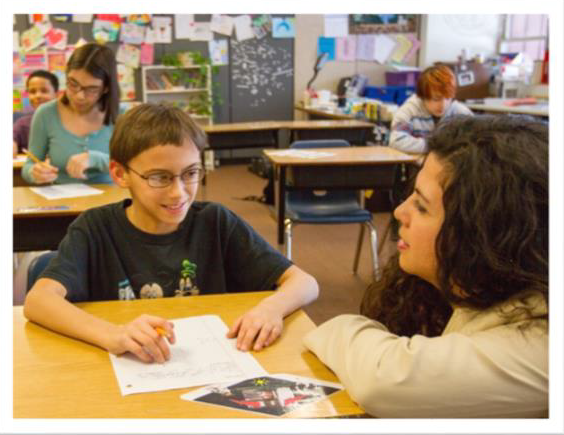
Figure 11. Child and educator
How Trauma Shows Up in the Classroom
Trauma’s Impact on Parent-Teacher Relationships
Historical boarding school trauma has had lasting impacts on the family relationships of AI/AN people and their ability to participate in Western educational institutions. For example, the way Native children were treated at the federal boarding schools may make students reluctant toengage in a classroom environment. Many of today’s AI/AN parents and grandparents were forcibly removed from their families and communities and sent to boarding schools, wherethey often experienced physical, emotional, or sexual abuse, or neglect.
Many of today’s AI/AN parents and grandparents were forcibly removed from their families and communities and sent to boarding schools, where they often experienced physical, emotional, or sexual abuse, or neglect. These experiences may make families uncomfortable about entering a school setting so closely tied to their traumatic experiences. Additionally, they may feel a lack of belonging due to cultural differences or a lack of community connections, which may altogether discourage a family from engaging with the community.
Reluctance to engage may also result from concerns about potential bias or discrimination. Negative attitudes toward AI/AN people persist among educators and other professionals, and microaggressions often occur in schools and related spaces (Johnston-Goodstar & VeLure Roholt, 2017). A recent study reported that 98% of Native young adults experienced microaggressions on a daily basis (Jones & Galliher, 2015). It’s no wonder, then, that parents may fear that their children will experience the same racism and marginalization they endured, and that any attempts to address the issue would only expose them to further trauma. In addition, parents who had negative experiences at school may have difficulty trusting teachers and administrators, making it difficult for them to form relationships with school staff and participate in their child’s education (Evans-Campbell, 2008).
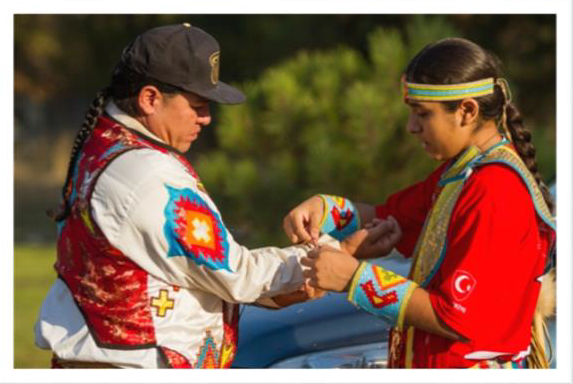
Figure 12. Native youth giving a bracelet to an elder
Activities: Reflection Questions
- Do I interrupt racist conversations and jokes when I hear my friends or colleagues talk that way?
- Do I actively seek to understand how I participate in both intentional and unintentional racism?
- Do I actively seek to educate myself about the experience of racism?
These questions were adapted from the Anti-racism Behavioral Inventory (Pieterse et al., 2016).
Educators and administrators can take several steps to build relationships with families with trauma histories. Staff should seek training on the history of Indian boarding schools and their impact on families, and then, with the engagement and guidance of local tribes, develop culturally relevant programs and curricula. School administrators should create opportunities for Native parents to participate in school decision making. By taking these steps, school communities can help to build trust with parents and create a more positive and supportive environment for all students and parents.
Call To Action: Nothing About Us Without Us
Nothing About Us Without Us. Non-Native educators and administrators must include AI/AN students, families, and tribal communities in the development of their culturally relevant programs and curricula. This is a crucial step in ensuring the material is accurate, culturally sensitive, and without stereotypes or microaggressions that might retraumatize AI/AN students.
Processing Trauma
Trauma can significantly impact a child’s development, both cognitively and emotionally. Children who have experienced trauma are more likely to have lower measures of cognitive functioning and motor and language skills (Prasad et al., 2005). Students with a history of maltreatment often exhibit learning and memory impairment (D’Andrea et al., 2012; Flaherty et al., 2006; Taylor & Siegfried, 2005). Even after the initial trauma has passed, reminders can cause a student to experience an intense, hyper- or hypo-aroused state once again, which gets in the way of learning (Shalka, 2015). Students who have experienced trauma are often referred for special education services, and get misdiagnosed with conditions like ADHD, oppositional defiant disorder, bipolar disorder, reactive attachment disorder, or depression (Fratto, 2016; van der Kolk, 2005).
Dramatic Storytelling
Dramatic storytelling as a model for trauma-informed care aligns with the principles of safety, trust, empowerment, and empathy. It provides a structured and therapeutic avenue for trauma survivors to share, process, and heal from their experiences while fostering a sense of community and understanding. When conducted by trauma-aware facilitators, dramatic storytelling can be a valuable tool in supporting individuals on their journey toward recovery and resilience.
Dramatic Storytelling Prompts:
- If “fear” was an animal, what animal would it be? If “healing” was an animal, what animal would it be? How would healing interact with fear?
- Recall a time when you were sad and what steps you took to resolve your sadness.
- Who helped you in processing your emotions? What words or actions did they share with you?
- Imagine a healing-centered classroom; how do the students and teacher feel and exist in this space?
Role of Educators
With proper training, educators can be powerful allies during team meetings and help children access necessary resources outside of class. When schools provide a safe, stable environment to students who have experienced trauma, they significantly aid the healing process (Brunzell et al., 2015).
Social Emotional Learning in the Trauma-Informed Classroom
Social and Emotional Learning (SEL) describes the process by which we learn to productively interact with others. This knowledge, skills, and attitudes allow young people and adults to develop healthy identities, manage emotions, achieve goals, display empathy, establish and maintain supportive relationships, and make responsible and caring decisions (Fundamentals of SEL, 2023). To support students’ needs, SEL presents five core competencies:
- Self-awareness
- Self-management
- Responsible decision making
- Relationship skills
- Social awareness
Call To Action: Educators Should...
- Advocate for appropriate support and services and make sure students receive them.
- Create a safe and supportive classroom environment that allows students to feel comfortable and safe while learning.
- Build a solid relationship with their students and their families.
Safe and supportive student-teacher relationships are foundational because relational trauma heals within safe relationships. Additionally, when students come out of a trauma response, they can learn more effectively. Understanding the impacts of students’ trauma, therefore, is necessary for educators to design the support and interventions that students need to learn the five core competencies of SEL.
How students act out depends on their age, the timing of their trauma, and many other factors. The following list describes some of the most common responses at each educational stage, but every student is unique, individual, and processes trauma in their own way.
Elementary
- Increase in stomach aches, pain, or headaches
- Changes in or inconsistent behavior
- Over- or under-reacting to sudden movements, touch, or loud noises
- Poor concentration
- Inconsistent school attendance
Middle and High School
- Self-consciousness
- Shame and guilt
- Self-destructive behavior
- Changes in interpersonal relationships
- Changes in school attendance and academic performance
Highlight: Student Survivors
“Some of our most important work with student survivors is simultaneously simple and complicated—bearing witness to their experiences. Being present for student survivors and the pain and challenges they endure can be difficult work, yet through that process, we are also holding space for the possibility of resilience to emerge and students to be able to fully participate as engaged learners” (Shalka, 2015).
Activities:
Reflection Questions:
- Have I asked my students and their families about what supports they need to fully engage with our school?
- Have I made any assumptions about behaviors I observe in the classroom?
- Do I have the proper training to understand how a history of trauma may impact my students learning or be misinterpreted as a disability?
- Have I connected with the people in my building or district who can be part of our trauma informed-healing centered support team?
- Have I connected with a cultural liaison, so I can become more informed on how to connect with my AI/AN students?
- Is my curriculum culturally relevant?
- Do my classroom materials reflect my student population?
Collage
Creating a visual representation by way of collaging, painting, or sketching is a powerful way to process complex emotions and foster healing through visualization. Creating a collage will require magazines and pictures, a posterboard, a pair of scissors, and a glue stick. Cut up the magazines and pictures and keep the images that resonate with you. Place the images on the posterboard and begin to glue them down. This is also a great exercise to use within the classroom with students of all age levels.
Collage Prompt:
- A trauma-informed and healing-centered classroom looks like …
- A trauma-informed and healing-centered community looks like …
Impacts of Trauma Later in Life
One study on ACEs and premature death concluded that people with six or more ACEs tended to die nearly 20 years earlier than the general population (Brown et al., 2009). Additionally, as an individual’s ACE score increases, so do other related risks, including issues with moods, physical symptoms, SUD, memory, sexual health, anxiety, smoking, obesity, and sleep issues (Anda et al., 2006).
Substance Use Disorder
The intergenerational impacts of boarding school trauma have also contributed to disproportionately high rates of SUD among AI/AN people (Chansonneuve, 2007). According to Dr. Gabor Mate, “addiction begins as an attempt to induce feelings that we were biologically programmed to generate innately and would have—if unhealthy development hadn’t got in the way” (2022, p. 232). When viewed through the lens of how trauma constantly disrupts AI/AN children’s development, along with the persistence of systemic inequalities toward AI/AN people, the high incidence of SUD is an unsurprising result. The opioid epidemic has been particularly devastating to AI/AN communities, as overdose deaths have increased more than fivefold over the past twenty years (Opioid Overdose Deaths, 2023).
VisitStopOverdose.org
Information on signs of an overdose. Instructions for obtaining and using naloxone (Narcan). Resources for providers and community members.
Challenged Relationships
People who have experienced trauma may also have difficulty forming and maintaining healthy relationships. They may mistrust others, have difficulty communicating their feelings, and experience the “fight, flee, fawn, or freeze” trauma response.
Strong Hearts: Native Helpline
1-844-7NATIVE (762-8483) Confidential domestic and sexual violence helpline for AI/AN, offering culturally appropriate support and advocacy.
Houselessness
Trauma and houselessness create a vicious cycle: while trauma acts as a risk factor for houselessness, houselessness also increases the risk of additional trauma (Buhrich et al., 2000; Robinson, 2014). In a nationally representative survey on houselessness, approximately 10% of AI/AN families with children aged 13‒17 reported youth houselessness or runaway experiences, and AI/AN young adults were three times more likely to be houseless than their White, non-Hispanic peers (Mortan et al., 2019).
Call To Action: Protective Factors for AI/AN Youth
Protective factors for AI/AN youth include personal wellness, positive self- image, self-efficacy, family and non-familial connectedness, positive opportunities, positive social normal, and cultural connectedness.
Unemployment
People who have experienced intergenerational trauma may have difficulty finding and keeping employment. They may have difficulty concentrating, following instructions, and working with others. They may also be more likely to experience anxiety and depression, making it difficult to function at work.
Suicide
While suicide is discussed in other areas of this toolkit, it is important to stress the close connection between self-harm and untreated trauma. (Afifi et al., 2007). WeRNative provides culturally appropriate support to people at risk of suicide, an especially important consideration when addressing boarding school trauma.
Crisis Text Line
Text “Native” to 741741. Crisis counselors are available 24/7 for confidential support and resources.
Decolonizing Mental Health and Substance Use Disorder Treatment
Other Crisis Lifelines
988 Suicide and Crisis Lifeline
Dial 988
Strong Hearts: Native Helpline
Dial 1-844-7NATIVE (762-8483)
Dial (877)565-8860
Dial 1-866-488-7386
Most commonly available treatments do not help AI/AN trauma survivors build healthier relationships with their communities and families. Because C-PTSD is often caused by relational trauma, any healing must occur in the context of relationships. Rather than healthy relationships being a result of successful treatment, teaching survivors to form, manage, and heal community relationships is an integral part of the treatment itself.
Post-traumatic Growth
While trauma is rarely one’s preferred method of personal growth, it does often result in increased resilience and transformation. This knowledge can give providers and families hope, knowing that survivors may ultimately form a deeper appreciation for life, develop new strengths and stronger relationships, open themselves to new possibilities, and deepen their relationship with their spirituality (Collier, 2016).
Call To Action:Culture is Prevention
Use traditional practices in recovery and ongoing therapies with your clients. Traditional drumming has been used for AI/AN people with substance use disorders and is a promising healing activity when coupled with traditional SUD therapies (Dickerson et al., 2012).
Activities:
Reflection Questions:
- Do I have the skills necessary to help my clients or students who are experiencing the long-term impact of trauma?
- If not, how can I build a network of other providers to refer my clients/students to when needed?
- Am I cautious to not ask questions that make my clients/students reexperience their trauma?
- Do I let my clients/students guide the conversation, so they only disclose what is
- comfortable to them and necessary for our work together?
Traditional Music
Traditional music, singing, and drumming hold profound significance for AI/AN people as vessels for prayer, community and family connection practices, and healing tools when confronting trauma. These cultural practices serve several important purposes:
- Cultural reconnection: Boarding schools aimed to erase cultures, languages, and traditions. Traditional music offers a means to reconnect with cultural roots, fostering a sense of identity and belonging that was forcibly stripped away.
- Spiritual healing: These cultural practices often have deep spiritual significance. Drumming, for instance, is a practice used to communicate with the ancestors and the spirit world. Engaging in these activities can help individuals find inner peace and spiritual healing.
- Community and support: Traditional music and drumming are communal activities, fostering a sense of unity and support among survivors and their communities. Coming together in song and dance can create a supportive environment for sharing experiences and healing collectively.
- Emotional expression: Music and singing provide a means to express complex emotions that may be difficult to articulate otherwise. Music allows survivors and their descendants to release trauma in a safe and culturally relevant way.
- Resilience and empowerment: Engaging in these practices can be an act of resilience and empowerment by reclaiming and practicing the traditions that were meant to be erased by forced assimilation. It demonstrates the survival of AI/AN cultures despite centuries of oppression and serves as a source of strength for individuals and communities.
If drumming or traditional music groups are not accessible, try integrating traditional music from your local communities into your classroom, office, or medical practice.
Resources
Child Trauma Toolkit for Educators
Culture is Prevention: SAMHSA Native Connections
The Opioid Crisis: Impact on Native American Communities
The Healing of the Canoe Curriculum: A life skills and SUD-prevention curriculum for tribal youth, designed to leverage a tribal community’s unique tapestry of traditions, beliefs, values, and stories to help Native youth gain both a deeper sense of belonging and a framework for success in life.
